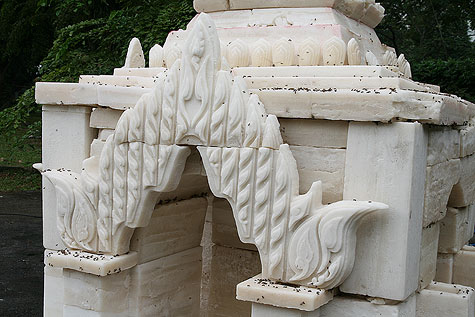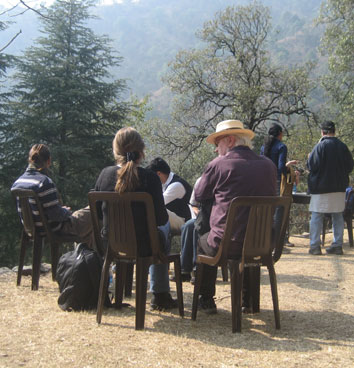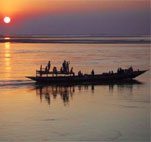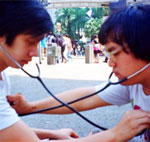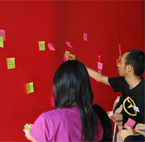ho chi minh city
Arriving in Ho Chi Minh city I felt as if the whole population were in mass exodus, 24 hours, the amount of traffic on the roads was quite overwhelming. When I told people I was visiting to HCMC, many turned up their noses asking ‘Why do you want to go there? It’s better to go to Hanoi’, I even got this response when I arrived in the city. Ho Chi Minh is the commercial center of Vietnam whereas Hanoi is seen as the cultural center, traditionally Vietnam’s home to the arts. However I had heard about the recent art developments in HCMC and was not disappointed, meeting many enthusiastic artists and engaging spaces, doing much to promote artistic activity in the city.

However contemporary arts in Vietnam as a whole face difficult challenges, in particular due to the heavy censorship, cultural policing and rigid education system. Many have commented upon the difficulty of accessing information about contemporary art and developments outside of Vietnam, which has led many artists to move abroad for study or for the general pursuit of their practice. But despite these difficulties there are an increasing group of creatives who are determined to raise the provisions for contemporary art in the city, from which a vibrant art scene is emerging.
san art

San Art is a non-profit artist run space in the centre of Ho Chi Minh which opened in June 2007. Within a year it has established a thriving community. Conceived as a space of experimentation San Art offers both young and mature artists, whose work has been overlooked by the commercial system the opportunity to show in a new context and try out ideas. The space is nurturing the contemporary arts in HCMC but also wider Vietnam. But it also has involvement in various international projects and frequently invites international artists/curators to presentations and lectures (recently Christian Marclay), with ties also to South America and South Africa.
San Art is the only space of its kind in HCMC, all other spaces are commercial or government run. The team of 5 directors say they are attempting to create a space which escapes the constant pressure to sell and allow for alternative forms of expression to emerge. The directors have all studied overseas in US, Australia or Europe, they have an experience of different cultures and an educational training which has grounded them in art theory and international contemporary art developments. They have been motivated to offer similar opportunities within the country, encouraging engagement in international art discourse and deeper discussion and debate upon these issues.
Through their contacts in particular in US they created a foundation in 2005 with a board of curators, collectors and advisors, support is based on their donations. Fundraising is a daunting task, but with this international support San Art is being enabled to pursue many activities. Before San Art began activity as a gallery it carried out a series of lectures in Hanoi University and in Ho Chi Minh to raise peoples interest in the project and engage in debate about contemporary art.
Discussing the art education system in Vietnam with Dinh Q Le it was clear that a very traditional perspective on art is maintained in the universities. Students are highly trained in the skills of their art – drawing, painting, sculpture, they are taught realism and documentary styles, however there is no support for critical thinking. The majority of contemporary artists in Vietnam study abroad and exhibit abroad. San Art aims to challenge this system, by providing an opportunity for both local and international artists to present their work in the city and offer an alternative form of education through lectures, workshops and its library resources.
tiffany chung

I met with Tiffany at Quynh Arts as she was installing her work for the TransPop Korea Vietnam Remix Show. She is presenting some of her latest work which involves a collaboration with one of Vietnam’s popular singers, Lam Truang. She has made a series photographs which she refers to as a Live Action Series, which are inspired by anime, science-fiction and manga. The exhibition consists of a selection of these photographs alongside sculptures which were also used in the scenes. These photos are also being used for the album cover of Lam Truang’s latest release and promotional material. The opening of the exhibition will be the release party for the album, including a live performance from the pop star.
We discussed this mix of contemporary art, entertainment and popular culture. Tiffany is captivated by pop culture, which she sees as a transnational phenomena. She is interested in how people select the products of popular culture to express their identity but also to identify with a group. Consumerism and the Art Market are important questions in her works. She is also interested in emerging cultures or underground culture. A key example would be the rise of Cos Play, dressing up as characters and playing out a role, often with a group of people. This Tiffany comments relates to notions of the ideal image and again a wish to express one’s individuality or hidden self. This poses questions to the social norms, particularly in Vietnam. Her next project will be a photo shoot in Shanghai, with a cos play group based in the city as part of a cos play festival. She is working with them to create a series of persona to feature in her work.
Her interest in performance and the projection of identity are further demonstrated in a photographic series mimicking the stereotyped images of communist iconography, figures in the heroic positions of workers solidarity and the soldiers battle, yet dressed in brightly coloured costumes and toy implements. The work addresses the notion of heroism in Vietnam and questions whether the image of the hero is still relevant.
Tiffany has been involved in many international projects and has a particular love of Japan, where she spent a residency at ARCUS centre in Ibaraki. Here she developed a number of projects including a city scape made of polystyrene, with vivid patterns of decoration, changing the visual encounter of the city, which is normally concentrated with advertising, into a colourful Development of consumerism juxtaposed with history
This use of decoration and pattern is also shown in her series of map drawings in which she revisualizes maps of Ho Chi Minh through a personal code of colour and shape, making her own additions to the city infrastructure, such demarking a subway system. Her work positions itself between utopia and dystopia, commenting on the socialist idea of utopian reconstruction, creating a seemingly idyllic space whose reality may be quite different.
Tiffany is also active as a curator, and a member of the San Art curatorial team. Her curatorial projects have included 'Scanning' by Ideta Goh and City Panaoramic, an international exhibition examining the urban landscape through photography.

galerie quyhn

Galerie Quynh was opened in 2004 as a commercial space to promote both local and international artists. Its ambitious programming presents cutting edge works and daring projects, despite its commercial status. Director Quynh sees the role of the gallery as being very much an educator, to promote contemporary art to ordinary people, to allow them to participate in it and learn more. But this can also be very challenging. Quynh comments that there is a lack of infrastructure in HCMC and Vietnam. Education does not support balance between technique and theory, there are a lack of spaces and there are also no critics as such to engage in constructive criticism. Also in these circumstances it is very difficult for the gallery to support its program. As a commercial gallery it is not eligible for support from foundations, so everything must be supported through the market. Work must be very ‘tight’ as Quynh puts it.
But despite this Quynh is making significant development and this year is making its international debut as one of the 23 participating galleries in Singapore art fair. In 2007 it out grew its original space (where san arts is now) and moved to a larger venue. Quynh is strongly supporting local artists but also bringing a focus to regional artists in South East Asia. Quynh has made significant contributions to the development of the arts community and through lectures, artist talks and publications has brought the awareness of contemporary art to a wider audience. The gallery has quite literally brought street life into its space, demonstrated through a performance event in which the local market was set up in the gallery. However the most impressive and ambitious projects are those which are often the most difficult to receive a license for from the cultural regulators. But Galerie Quynh continues be at the cutting edge of contemporary art in HCMC and is providing important support for both artists and new audiences.
hoang duong cam

I met Cam in his studio in a high rise apartment block in the north of the city. He had just finished filming his new work ‘Falling – Cloud’ to be shown in ‘Strategies from Within’ at Ke Center for Contemporary Arts, Shanghai. This involves Cam with a huge cloud stuck to his head riding around on a bicycle which is far too small for him. ‘Here it is now the law that you have to wear a helmet when riding on a motorbike, but riding a bicycle is much more dangerous’ he comments.
Cam studied at art school in Vietnam and received very traditional teaching in painting but was always aware of wider practices and has developed his own unique and often humorous yet highly philosophical approach to making art. He works broadly between painting, media, installation, photography and states that he likes to get the balance between the high tech and the low tech. He is also much inspired by Quantum physics and Murakami Haruki’s fiction to which he makes reference in some of this works.
A recent project ‘Elephant’ demonstrates some of these levels. A stop frame animation (made using a digital stills camera) presents the artist whose body is gradually covered by brightly coloured toys eventually taking the form of a giant mass. Cam relates the title to the old Buddhist tale of 4 blind men who encountered an elephant. Cam explains that an elephant appears soft and friendly but it is also at the same time threatening its size and strength have the potential for harm. This dichotomy Cam links to the economic situation in Vietnam, where significant developments are being seen but in entering new territory this also brings new fears.

In 2005 Cam participated in an artist in residency program at
Huntington Beach Arts Center, California, where he realized the
project 'Beach Eggs'. In this project visitors to the beach were
invited to blow their secrets into a balloon and bury them in the
sand, coming to resemble eggs, their secret pregnant, a potential
for another life.

Some of Cam's earlier works demonstrate his long interest in media forms, including 2001's 'Under the Covers', a mixed media installation consisting of video projection examining a figure from various angles and a screen of calligraphy formed from 'muong' Vietnamese boiled vegetables. The calligraphy imitates Chinese characters, yet are actually imagined symbols. Cam aims to demonstrate in this work many ways to value a person, many faces behind the one we present to the world can not understand one culture according to the customs of another in order to understand a culture must live within it and digest its various elements, written word is just one interpretation

a little blah blah

Initiated in 2005 by Sue Hadj, Matoko Uda and Nguyen Nhu Huy as a resource for contemporary art and interdisciplinary dialogue in HCMC. A key feature of albb has been its presentation of many international artists through a residency program, collaborative projects and special lectures/events. Since its inception albb has been incredibly active with a stream of events throughout each year in a tireless effort to encourage new perspectives and exchanges. Its program includes creative projects, exhibitions & events, screenings, talks, internships and an open-access archive of art books & catalogues.

The Bao Loc Project http://www.baolocproject.org 2007 was a project in a regional province of Vietnam which brought together artists, architects and urban planners from HCMC, Hanoi and abroad to engage over a 4 week period with a very different context, a rural landscape and its people. The artists realized a variety of personal and collaborative projects/interventions in this area, working closely with local residents and forming new communication. Director Sue Hadju's contribution included making a gift of a birthday cake to various households in the village, who would find the cake mysteriously on their doorstep in the morning, then eventually all these households were brought together in a birthday party celebration, in which the cake giver was finally revealed.

Their most recent project Superstructure brings together artists from Finland, Norway, Sweden & Denmark to collaborate with local artists and residents of HCMC. This project is again highly concerned with social interaction in the city and discovering the various conditions which people face, making some response to this in some form of intervention.

Another exciting project has been ‘The last vestige’ curated by Thea Baumann . This was a 1 night event which took place on a historical boat on the Saigon river. Each room of the boat became an exhibition for the participating artists. The event has been described as a ‘series of mini-dramas, site-specific installation and performance works drawing inspiration from themes related to time-travel, mutancy, and pirate utopias.’ The energetic challenging work proposed a questioning of the future in a movement of entertaining tableaux which built to a single point.
http://albbsaigon.blogspot.com/

richard streitmatter-tran

Richard is one of the most active artists internationally, based in HCMC. He grew up in US and studied at Studio for Interrelated Media (SIM) at the Massachusetts College of Art in Boston and MIT. He then came to Vietnam shortly after. He works across disciplines including performance, photography, video, installation and sculpture. When I met him and his partner, Chaw Ei Thein, who is also an artist, they were testing mixes of lime and sugar in preparation for an ambitious collaboration project for Singapore Biennale, a temple made of sugar ‘September Sweetness’.
Richard is highly interested in the impact of mass media and media technologies on the distribution of information and the development of society. During his research at MIT, Aesthetics and Computation department, he made a number of projects which question the information we receive and how we consume it. ‘Sound Interventions’ 2001 was made with a team from MIT in which they hacked a newspaper vending box, when the box was opened it would playback through a speaker challenges to headline news, which the public could also record themselves. ‘Cell Phone Interventions’, a humorous comment upon the operation of public and private space in relation to the mobile phone, involved a fellow artist enclosing himself in a mini, mobile phone booth every time he spoke on his phone. Furthermore ‘Vieques’, questioned the information in the city, by creating a protest message on the Boston Subway information boards, using the architecture of the city creating a near invisible graffiti which stayed for 2 days, before anyone realized, highlighting the habit of the city and how accustomed we are to ignoring unnecessary information.

A key research point for Richard has been the urban condition. ‘Urban attractors/Private distracters’ was a project realized in 2007 as a collaboration between NYC, HCMC and Kassel, involving groups of students and young artists. This was a collaboration with Angie Eng and was supported by Turbulance and Eyebeam. The groups dressed in laboratory coats as if making a scientific investigation explored the city and denotated its private and public spaces, examining the visual environment and the definitions of urban space, commenting through the use of signs upon the function of these spaces and the participation or lack of participation which they offer.
His work was recently included in Thermocline of Art new asian waves ZKM, 2007, which was an ambitious ‘overview’ of contemporary art/media arts in Asia, curated by Wonil Rhee. Here he presented a photographic series entitled ‘Meso Veilia or the water treaders’. This work was made at an artificial waterfall theme park with over 50 people dressed in bright orange life jackets playing amongst the falls, the work commenting upon the particular economic condition in Vietnam which is likened to treading water.
Richard is also a member of Mogas station, a collective of 8 artists based in HCMC/Hanoi, initiated in 2005. They realized their first major project in 2006 Singapore Biennale Aart and LZ which involved the mass production of an art magazine designed for a Vietnamese audience and presented as if they were aid packages or propaganda dropped from aircraft (landing zones). This work points towards the lack of information about contemporary art in Vietnam (but also the general control of information here) but with the realization that when considering how to disseminate information there is a need for a structure, it cannot just be dropped. The group also realized a project in 2007 ‘Rokovoko’ which includes each member on a solitary raft, floating in the middle of the ocean, a commentary on the reality of place.

During his earlier research at MIT Richard made a number of investigations into the nature of media itself, asking technology to reflect upon itself as shown for example in ‘Technology and its precursor’ using video camera and eletroset mixing old and new technology in an attempt to communicate to the audience and transfer information. ‘Information Instances’ demonstrated an experiment in how many copies of oneself can be displayed in one screen in a feedback loop. And ‘Introspection Machine’ presented at Siggraph 2001 involved a machine eternally gazing at itself through itself.
This interest in what technology sees and what it does not, the framing which it presents and how we as humans adapt to this frame what pursued further in Richards solo exhibition. Bodyframe/videoframe 2004 at L’space, Hanoi. Here Richard also combined his interest in performance and the body in a collaboration with 3 circus dancers. A circus has a large arena and can be viewed from many angles and the dancers in this context are experts at manipulating space but Richard gave them the restriction that they could only dance within the frame of a video camera, they had to imagine this virtual frame around them and create a choreography for this instance.
 v
v
Commenting on the arts community in HCMC Richard stresses that it is not territorial, there is not the rivalry which is often associated with contemporary art, artists and curators are very supportive of each other, sharing their information sources and encouraging many dialogues. He acknowledges the problems which artists in HCMC and Vietnam face but also stresses the strength they gain from this and points towards the positive impact which they can have on wider society.
Richard has just completed an extensive research project 'Mediating the Mekong' funded by the Asia Art Archive. This was an intense year long investigation into the Mekong region, the Mekong river being one of the largest in Asia which flows through China, Myanmar, Laos, Thailand, Cambodia and Vietnam. The Mekong was taken as a metaphor for the flow of information in these regions, in an examination of media infrastructures and the role of technology and mass media in promoting access to but also controlling this information. He particularly focused upon information about the contemporary arts, what provision is made for distributing and sharing this information both in terms of import and export and circulation, also challenging the lack of awareness internationally of the contemporary arts developments in this area. You can read the full report here:
www.meta-house.com/download.php?filePath=downloads/md_final_report.

nguyen nhu huy

Nhu Huy is an artist, curator, critic, translator and writer who has been most active in the HCMC art scene. In 2007 he realized a 3 month public art project Art in Marathon with the support of Arts Network Asia. This involved collaborations between artists and the public exploring the local area and how art can be created through not making art, but by communicating with each other.
Nhu Huy comments that there is not enough information on contemporary art available in Vietnam, he is trying to raise awareness of it and bring it into people’s everyday lives. He spent 3 years working on a website for contemporary art in Vietnamese. But he is very careful about how to educate and inform people he comments that information should not just be input it needs to be produced, people must produce their own understandings and creative response. He emphasizes the necessity of applying what you have learnt into a new discourse.
The importance of reality is well understood by Nhu Huy. The importance of being down to earth, to see the clear situation and how best to tackle it or integrate with it. Working with a deep dialogue with the public and opening up that dialogue to broad participation is central to his art activity. In his pursuit to widen participation in contemporary art he emphasizes the joyfulness of making art.
As part of this ambition he set up a little blah blah in 2004 with Sue Hadju and Matoko Uda. They recognized the need for fresh information about contemporary art and wanted to give the general public and the arts community exposure to new developments. A key element of albb has therefore been its artist in residency program inviting artists from abroad to engage in a project and dialogue with the local people. Collaboration is very much central to Nhu Huy’s thinking as he stresses that the flow of information should not just be one way, there are many different modes of learning, any form of education is a two way process.
Speaking of his own background Nhu Huy says that studying Fine Art at Ho Chi Minh Art university he was taught an emphasis on skill, but he wanted to find something else, a room for expression and was very interested in abstract expressionism. Then after participation in a residency program in US for 3 months his concerns were brought to conceptual art with a move away from visual. But he is very aware of the alientation an audience can feel in many instances of contemporary art, especially conceptual art, commenting on the gap between artist and audience often requiring a translator.
Nhu Huy is now planning the 2nd art in marathon in which he is hoping to create a shop/gallery space for 6months-1year in which artists can come together with local people in workshops and events.
wonderful

Wonderful District is an 8 years collaboration between Bertrand Peret and Sandrine Llouquet which began in France and is now based in HCMC. Their starting point was an interest in art, electronic music and performance and were both very influenced by visual design. They began collaborating on artistic projects including organizing multi-disciplinary events and publishing art/design magazines.
Then in 2005 they moved to HCMC and established themselves here, making their apartment into a gallery/museum/library/public event space. Here they set up an artist in residence program inviting international artists to make projects in HCMC. They also initiated an event program Atelier Wonderful which was held every week for over 6 months. The last event of which involved 50 artists, over 3 days in two cities. They appear to have an unstoppable energy and a great determination to do all they can for the art scene in HCMC. They have also been organizing a series of electronic music and sound art events. This began in 2005 with an event ‘Rendezvous’ for electronic art and music at gallery Quynh and Blue Space in an attempt to promote and discuss digital culture.
Their activities are not just confined to HCMC, they are also creating projects in other parts of Vietnam, wider South East Asia, Europe and recently America. They are concerned in each event to create an interrogation of its time and place. Their interest in curation is also linked to their magazine publishing activity which they began in France and still continue in Vietnam. They talk of the space of the magazine being like an exhibition space in which they can curate the content and create meaning through the arrangement in the space of the page. They also comment upon the urgent necessity of information about contemporary art in Vietnam and how a magazine could make a significant contribution to this, to generate further dialogues, circulate ideas and develop the direction of arts activity.
Bertrand in particular is now very active in promoting experimental and electronic music in the city and he with a number of colleagues are regularly organizing events in clubs and galleries to offer the opportunity to hear new sounds and bring together various djs, musicians, vjs and sound artists. The music scene of Vietnam is mainly based in Hanoi so it has been a challenge to cultivate such a new movement in HCMC, however there are a number of artists experimenting in this field and through various events including conceptual parties and sound installations they have been encouraged to develop their skills and deepen their investigations, while at the same time attracting new audiences.
A recent project is based on architecture and combines both low and hitech methodologies. Working with an architect and engineer they have created AliceIn which is a nomadic, modular bamboo structure in which they invite artists to create something at different locations. During its first presentation in HCMC AliceIN was held at 4 sites, including gallery space, public space and a garden space. Here artists created sound performance, projection, light installation for the mobile space. They are planning many further collaborations for this project and are touring it to many other cities.
They were also involved in ‘Fying Circus : Travelogue’ by TheatreWorks ( a company based in Singapore) in November 2007. Flying Circus was initiated in 1994 as a ‘transcultural, inter-disciplinary, long-term research and development programme consisting of performances, screenings, conversations, laboratories, workshops, talks and engagement with local communities’, bringing together artists from Singapore and Vietnam.
Bertrand comments ‘Temporary autonomism is central to our activity, it is ephemeral, one can’t achieve utopia forever, it is just one poetic moment’.
http://www.wonderfuldistrict.org

nguyen duc tu

Tu is a young artist who was educated at Hanoi Fine Art University where he studied graphic design. An artist of considerable energy he is interested in all forms of art but in particular audio/visual media art. He freely works across disciplines currently active as visual artist, graphic designer, photographer, VJ and a particular focus at the moment is television production, he produces a program each week for Vietnam MTV.
He is very excited by the possibilities offered by new media and very eager to explore these. The opportunity to collaborate with British audio/visual collective DFUSE in their British Council supported Re-imaging the City project has further inspired him to continue work in this field. He has also engaged in projects and collaborations with other international artists, including a residency project in Korea.
His recent works include:
Pho is a simple video animation displaying the letters Pho, but with the accents of the Vietnamese language constantly changing around them. Depending on these accents, the meaning of the letters changes, it can have up to 20 different meanings, this constant shift of meaning comments upon the need for variety of perspective. PingPong - A 3 way ping-pong game in which Tu plays against himself presented using large scale projection on the architectural surfaces of the city. Panorama presents a 360 interactive panorama of various sites in HCMC. Goodbye and Goodluck is an experimental video, featuring symbols of the pig, a sign of good luck and comments upon ideas of fate in traditional culture. He is also currently investigating documentary film and performance.





